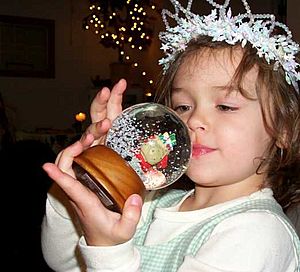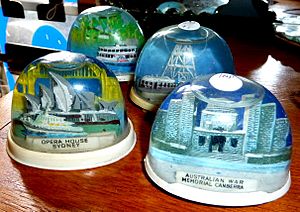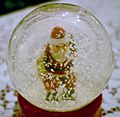Snow globe facts for kids
A snow globe is a clear, round container, usually made of glass. Inside, you'll find a tiny scene, like a town, a landscape, or a small figure. The globe is filled with water, and when you shake it, white particles float around, looking like falling snow. After shaking, the "snow" slowly settles down through the water. Some snow globes also have a music box that plays a tune. Many people enjoy collecting snow globes.
Contents
History of Snow Globes
Snow globes were first invented in Austria in the late 1800s. A man named Erwin Perzy, who made surgical tools, created the first "Schneekugel" (snow globe). He was trying to make a brighter light for surgery. While experimenting, he saw how particles floated in water, and it reminded him of snow. This gave him the idea for the snow globe.
His first real snow globe had a tiny model of the Mariazell basilica inside. People loved his snow globes so much that Erwin and his brother Ludwig opened a shop in Vienna. This family business still makes snow globes today! The special material they use for the "snow" is a secret passed down through generations. It's designed to float in the water for a long time before sinking.
In the United States, the first patent for a snow globe was given to Joseph Garaja in 1927. During the 1940s, snow globes became popular for advertising in America. In Europe, religious snow globes were common gifts for children in the 1940s and 1950s. A famous snow globe appears at the beginning of the 1941 movie Citizen Kane.
In the 1950s, snow globes started being made from plastic instead of just glass. Today, you can find many different kinds of snow globes. They are made all over the world, from large factories in places like Hong Kong and China to small, detailed workshops in Austria. Snow globes show all sorts of scenes, from holiday themes to Disney characters, animals, and historical moments.
Since the year 2000, even fashion and luxury brands have started using snow globes. They see them as special items that represent their brand. Some artists, like Walter Martin & Paloma Muñoz, also use snow globes in their art.
What's Inside a Snow Globe
Early snow globes had a heavy glass dome over a small ceramic figure. The base was often made of black ceramic. The "snow" was made from things like bone chips, porcelain pieces, sand, or even sawdust.
As they got better, the glass became thinner. The bases were made from lighter materials, like Bakelite. The "snow" was then made from gold foil or special soap flakes that wouldn't dissolve. Today, for safety, the "snow" is usually made of white plastic.
The liquid inside has also changed. It used to be a light oil. Now, it's often a mix of water, antifreeze, and glycerol. Glycerol helps the "snow" fall slowly. It's important to be careful if a snow globe breaks. The liquid can be harmful to pets like cats and dogs if they drink or lick it.
Cool Features of Snow Globes
Modern snow globes can have many cool additions. Some include music boxes that play songs. Others have moving parts or internal lights. Some even have electric motors that make the "snow" move constantly, so you don't have to shake them. You can also find globes with slots to put your own photos inside.
Different Kinds of Globes
In 2005, large inflatable snow globes became popular for Christmas decorations. These have a fan in the base that blows air. This air carries small plastic pellets up a tube, and they fall down inside the clear front, looking like snow. The rest of the globe and the figures inside are made of colorful nylon fabric. These are often big decorations for front yards and light up at night.
Another type is the "tornado globe." In these, small foam objects spin around inside. These are popular for Halloween, with foam bats or ghosts flying around spooky figures.
Snow Globes in Movies
Snow globes have appeared in many films:
- The movie Citizen Kane (1941) begins with the main character holding a snow globe. He says his last word, "Rosebud," and the globe falls and breaks.
- In The Santa Clause (1994), Charlie Calvin gets a magical snow globe from an elf. When shaken, a sleigh flies inside it. This globe helps his dad, Scott, believe in Santa.
- The special edition of the movie Fargo (1996) came with a snow globe that had both snow and "blood" when shaken.
- In Unfaithful (2002), a character uses a snow globe as a weapon.
- The film Snowglobe (2007) is about a magical snow globe that takes the main character to a world where Christmas spirit is always present.
- In the animated film Coraline, Coraline's parents are trapped inside a souvenir snow globe.
- Pixar's short film Knick Knack (1989) is about a snowman in a snow globe trying to escape.
Snow Globes in Books
- In Libba Bray's book Going Bovine (2009), snow globes are used as a symbol for the limits of reality. The characters break them to "free the snow globes."
- In Erica Rand's The Ellis Island Snow Globe (2005), a snow globe from the Ellis Island gift shop helps show how history is sometimes told in a certain way.
Snow Globes in Television
- The British TV comedy series, The League of Gentlemen, often featured snow globes. They were sometimes important to the show's story.
- The final episode of the TV series St. Elsewhere famously suggests that everything that happened in the show was just a fantasy. It was imagined by an autistic boy whose favorite toy was a snow globe with a tiny model of the hospital inside.
Snow Globes in Art
- The artworks of Walter Martin & Paloma Muñoz often use snow globes as a key part of their creations.
Images for kids
-
A snow globe with a figurine of Santa Claus
See also
 In Spanish: Bola de nieve (juguete) para niños
In Spanish: Bola de nieve (juguete) para niños




